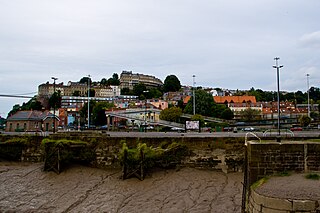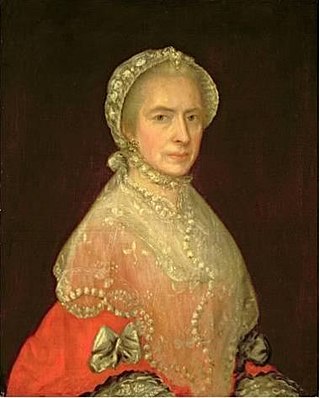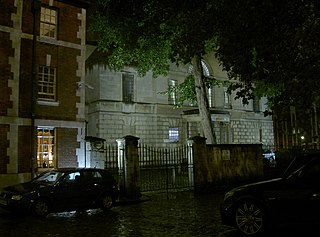
Hope Chapel is home to Hope Community Church in Hotwells, Bristol, England. It is a Grade II listed building. [1]

Hope Chapel is home to Hope Community Church in Hotwells, Bristol, England. It is a Grade II listed building. [1]
The chapel was founded by Lady Henrietta Hope and Lady Glenorchy after visiting the Georgian natural hot spa resort in 1784. Lady Hope gave £2,500 towards the cost and Lady Glenorchy agreed to have it done. Lady Hope was ill and her friend decided to name it in her honour. However they both died in 1786 so it was Glenorchy's executor that completed their wishes. [2] It is said that they decided to build it after finding that the only place of worship was up a steep hill in Clifton. [3] [4] By 1851 the church had an attendance of 600 to 700 in the morning and 700 to 800 in the evening.
By the 1970s attendance was falling and by 1980 it was no longer used as a place of worship. [5] It then became a community centre named the 'Hope Centre', before reopening in 2000 as Hope Community Church, a Congregational Church. [6]
Between 2006 and 2013 Bristol and Regional Archaeological Services (BaRAS) maintained a watching brief overseeing works to excavate the crypt ready for conversion into public space. [3]

The south front has four bays with pilasters. Within the hall there is a balcony supported on cast iron columns. [1] The interior includes memorials to many members of the congregation from the late 18th and early 19th centuries. [7]
Records of Hope Chapel, Hotwells are held at Bristol Archives (Ref. 38545) (online catalogue) including baptism, marriage and burial registers.

Bow Church is the parish church of St Mary and Holy Trinity, Stratford, Bow. It is located on a central reservation site in Bow Road, in Bow, in the London Borough of Tower Hamlets. There has been a church on the same site for approximately 700 years. The church was bombed in the Second World War, and the bell tower was reconstructed just after the war.

Hotwells is a district of the English port city of Bristol. It is located to the south of and below the high ground of Clifton, and directly to the north of the Floating Harbour. The southern entrance to the Avon Gorge, which connects the docks to the sea, lies at the western end of Hotwells. The eastern end of the area is at the roundabout where Jacobs Well Road meets Hotwell Road. Hotwells is split between the city wards of Clifton, and Hotwells and Harbourside.

Bishopsworth is the name of both a council ward of the city of Bristol in the United Kingdom, and a suburb of the city which lies within that ward. Bishopsworth contains many council estates.


Willielma Campbell, Viscountess Glenorchy was a patroness of evangelical missionary work and founder of several chapels in Scotland, England and Wales.

Church of Holy Trinity is an Anglican church in Hotwells, Bristol, England. It has been designated as a grade II* listed building.

St Mary on the Quay is a Roman Catholic Parish church in Bristol, England. It is situated on Colston Avenue, next to Colston Tower in the centre of the city. It is the oldest Roman Catholic church in Bristol; the first one built after the Reformation. it was formerly administered by the Society of Jesus and is currently served by the Divine Word Missionaries. It is a Grade II* listed building.

St Mary's Church is the parish church for the town of Gillingham in the Blackmore Vale in the north of Dorset. The church is in the Diocese of Salisbury in the Church of England, and part of the Anglican Communion.

Saint Augustine's, Kilburn, is a Church of England church in the area of Kilburn, in North London, United Kingdom. Because of its large size and ornate architecture, it is sometimes affectionately referred to as "the Cathedral of North London", although the church is not a cathedral in any official sense.


A redundant church, now referred to as a "closed church", is a church building that is no longer used for Christian worship. The term most frequently refers to former Anglican churches in the United Kingdom, but may also be used for disused churches in other countries. Redundant churches may be deconsecrated, but this is not always done.


St Dominic's Priory Church is one of the largest Catholic churches in London. The church is Grade II* listed building on the National Heritage List for England. It has been served by the Order of Preachers (Dominicans) since 1861, the community living in the adjacent Priory. In October 2016, the church was solemnly inaugurated by the Cardinal Archbishop of Westminster, Vincent Nichols, as a diocesan shrine, with a designated mission of promoting the Rosary.

Ascot Priory is a former priory in Berkshire, England, established in 1861. It was the mother house of the Society of the Most Holy Trinity, a community of nuns within the Anglican Communion. It now serves as a church and spirituality centre.

Lewin's Mead Unitarian meeting house is a former Unitarian church in Bristol, England.

St Thomas Syriac Orthodox Cathedral Acton is a Syriac Orthodox Cathedral in Acton, London, England, formerly known as St Saviour's Centre for the Deaf Anglican church, which was a social centre for deaf people, and the first and only purpose-built church for deaf people as such. St Saviour's was the central location for the London Diocesan Chaplaincy among Deaf and Deafblind people. The church and social centre closed in 2014 following a loss of funding, and insufficient financial reserves to maintain the premises. The final church service was held on Wednesday 24 September 2014, at which the Bishop of Willesden officiated.

St Edmund's Church is the Roman Catholic parish church of Godalming, a town in the English county of Surrey. It was built in 1906 to the design of Frederick Walters and is a Grade II listed building. The church stands on a "dramatic hillside site" on the corner of Croft Road just off Flambard Way close to the centre of the town.

Henrietta Place, originally known as Henrietta Street, is a street in Marylebone in the City of Westminster in central London that runs from Marylebone Lane in the east to Cavendish Square in the west. It is joined on the north side by Welbeck Street and Wimpole Street, and on the south side by Vere Street, Chapel Place, and Old Cavendish Street.
Lady Henrietta Hope was a British benefactor from Scotland. She was a lifelong friend of chapel builder Willielma Campbell and Hope Chapel in Bristol is named after her.
Lady Glenorchy's Church or Chapel in Edinburgh was a church founded in the 18th century by Willielma Campbell, Viscountess Glenorchy. It was made a quoad sacra parish in 1837.